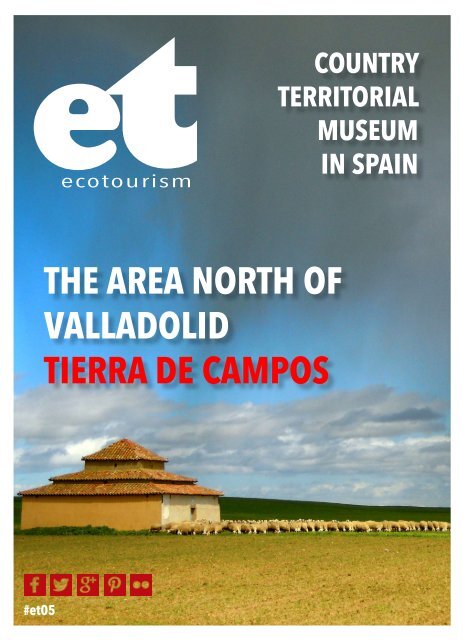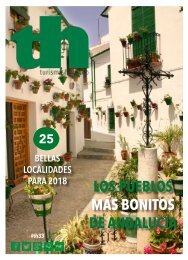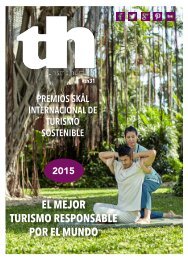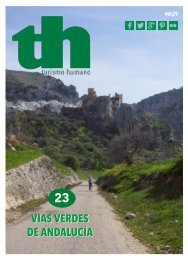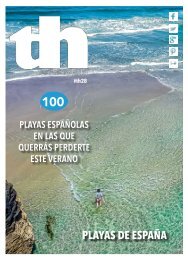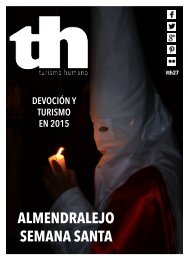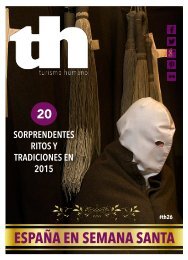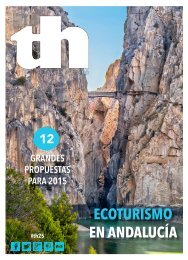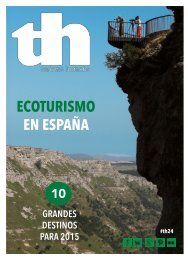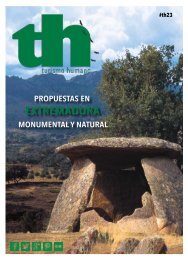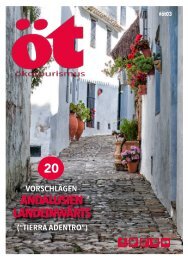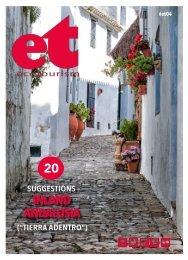Ecotourism 05. The Area North of Valladolid in Spain. Tierra de Campos
The Tierra de Campos district in the province of Valladolid in Spain has a singular beauty of its own, dominated by the contrasts and intensity of the colours
The Tierra de Campos district in the province of Valladolid in Spain has a singular beauty of its own, dominated by the contrasts and intensity of the colours
- No tags were found...
Create successful ePaper yourself
Turn your PDF publications into a flip-book with our unique Google optimized e-Paper software.
et<br />
ecotourism<br />
COUNTRY<br />
TERRITORIAL<br />
MUSEUM<br />
IN SPAIN<br />
THE AREA NORTH OF<br />
VALLADOLID<br />
TIERRA DE CAMPOS<br />
#et05<br />
<strong>Ecotourism</strong> 1
#et05<br />
Spa<strong>in</strong><br />
Other magaz<strong>in</strong>es <strong>of</strong> <strong>in</strong>terest<br />
2 <strong>Ecotourism</strong>
CONTENTS<br />
nº 05<br />
<strong>The</strong> <strong>Area</strong> <strong>North</strong> <strong>of</strong> <strong>Valladolid</strong><br />
<strong>Tierra</strong> <strong>de</strong> <strong>Campos</strong><br />
STAFF<br />
[Edited by] CM<br />
[Published by] SH<br />
[International] JAS<br />
[Commercial <strong>de</strong>partment]<br />
CM / PGR<br />
[Webmaster] fix-si.com<br />
[Translation] Susan Mitchell<br />
[Photos]<br />
[Cover photo]<br />
Pigeon-house <strong>in</strong> Bolaños <strong>de</strong> <strong>Campos</strong><br />
(<strong>Valladolid</strong>, Spa<strong>in</strong>)<br />
© MOLINA Y GUZMÁN<br />
04. TIERRA DE CAMPOS the<br />
ancient Gothic Pla<strong>in</strong>s <strong>of</strong> the Visigoths<br />
(Campi Gothici or Campi Gothorum),<br />
makes up an evocative landscape <strong>of</strong><br />
wi<strong>de</strong> horizons.<br />
08. COUNTRY TERRITORIAL<br />
MUSEUM <strong>The</strong> whole <strong>of</strong> the <strong>Tierra</strong> <strong>de</strong><br />
<strong>Campos</strong> district at becom<strong>in</strong>g a cultural<br />
theme park.<br />
10. SPANISH MOORISH ART <strong>The</strong><br />
cultural heritage <strong>in</strong>clu<strong>de</strong>s some appeal<strong>in</strong>g<br />
Spanish Mu<strong>de</strong>jar monuments.<br />
14. FOLK ARCHITECTURE <strong>The</strong><br />
pigeon-house has been recovered for<br />
breed<strong>in</strong>g pigeons.<br />
18. BIRDWATCHING <strong>The</strong> extensive<br />
landscape <strong>of</strong> <strong>Tierra</strong> <strong>de</strong> <strong>Campos</strong> is a<br />
great natural attraction.<br />
24. ROUTES Stone Columns, museums,<br />
rivers, nature, the Castilla<br />
canal, Pilgrim Way <strong>of</strong> Sa<strong>in</strong>t James and<br />
pigeon-houses.<br />
42. FESTIVALS, TRADITIONS<br />
AND GASTRONOMY <strong>Tierra</strong> <strong>de</strong><br />
<strong>Campos</strong> has a varied cuis<strong>in</strong>e based on<br />
its natural resources.<br />
44. PRACTICAL INFORMATION<br />
Internet l<strong>in</strong>ks and Practical <strong>in</strong>formation<br />
to prepare your trip.<br />
<strong>Ecotourism</strong> 3
<strong>Tierra</strong> <strong>de</strong> <strong>Campos</strong><br />
<strong>Valladolid</strong><br />
Traditional adobe pigeon-houses <strong>in</strong> Roales <strong>de</strong> <strong>Campos</strong><br />
4 <strong>Ecotourism</strong>
<strong>The</strong> <strong>Area</strong> <strong>North</strong> <strong>of</strong> <strong>Valladolid</strong><br />
<strong>Tierra</strong> <strong>de</strong> <strong>Campos</strong><br />
MOLINA Y GUZMÁN<br />
<strong>Tierra</strong> <strong>de</strong> <strong>Campos</strong>, the ancient Gothic<br />
Pla<strong>in</strong>s <strong>of</strong> the Visigoths (Campi Gothici<br />
or Campi Gothorum), makes up<br />
an evocative landscape <strong>of</strong> wi<strong>de</strong> horizons<br />
which transmits peace and serenity to visitors<br />
to enjoy <strong>in</strong> a place where time has no<br />
importance. It is an i<strong>de</strong>al district for those<br />
<strong>in</strong> search <strong>of</strong> relaxation with pleasant and<br />
out <strong>of</strong> the ord<strong>in</strong>ary sensations. Its heritage,<br />
nature, gastronomy and traditions are<br />
recommendations for visit<strong>in</strong>g, completed<br />
by an attractive museum <strong>of</strong>fer as well as the<br />
<strong>in</strong>terpretation centres..<br />
<strong>The</strong> <strong>Tierra</strong> <strong>de</strong> <strong>Campos</strong> district <strong>in</strong> the prov<strong>in</strong>ce<br />
<strong>of</strong> <strong>Valladolid</strong> has a s<strong>in</strong>gular beauty <strong>of</strong> its<br />
own, dom<strong>in</strong>ated by the contrasts and <strong>in</strong>tensity<br />
<strong>of</strong> the colours. To the north and northeast<br />
it bor<strong>de</strong>rs with the prov<strong>in</strong>ce <strong>of</strong> León; to<br />
the south with the municipal area <strong>of</strong> Med<strong>in</strong>a<br />
<strong>de</strong> Rioseco (<strong>Valladolid</strong>); to the east with the<br />
prov<strong>in</strong>ce <strong>of</strong> Palencia and to the west with<br />
the prov<strong>in</strong>ce <strong>of</strong> Zamora.<br />
<strong>The</strong> territory is marked by small rural villages<br />
with an average number <strong>of</strong> <strong>in</strong>habitants<br />
<strong>of</strong> 200 to 300. Villalón <strong>de</strong> <strong>Campos</strong> and<br />
Mayorga exceed this number <strong>of</strong> <strong>in</strong>habitants<br />
with 2.000 and <strong>in</strong> Aguilar <strong>de</strong> <strong>Campos</strong>, Becilla<br />
<strong>de</strong> Val<strong>de</strong>raduey, Bolaños <strong>de</strong> <strong>Campos</strong><br />
and La Unión <strong>de</strong> <strong>Campos</strong> the population is<br />
between 300 and 400 <strong>in</strong>habitants. 14 villages<br />
have a population <strong>of</strong> fewer than 100<br />
<strong>in</strong>habitants. <strong>The</strong> average <strong>de</strong>nsity is low and<br />
barely reaches 8 <strong>in</strong>habitants/km 2 .<br />
<strong>Tierra</strong> <strong>de</strong> <strong>Campos</strong> is characteristically ma<strong>de</strong><br />
up <strong>of</strong> pla<strong>in</strong>s and farmland where cereal<br />
crops are grown and its economy is basically<br />
agricultural.<br />
<strong>Ecotourism</strong> 5
<strong>Tierra</strong> <strong>de</strong> <strong>Campos</strong><br />
<strong>Valladolid</strong><br />
INTERACTIVE MAP<br />
SPAIN<br />
To Valencia <strong>de</strong> Don Juan<br />
Roales <strong>de</strong> <strong>Campos</strong><br />
Río Cea<br />
To Benavente<br />
N-610<br />
Castrobol<br />
Río Val<strong>de</strong>raduey<br />
N-601<br />
To León<br />
Dehesa <strong>de</strong> San Vicente<br />
En<strong>de</strong>mic Birdlif<br />
Interpretation C<br />
Monasterio <strong>de</strong><br />
Game Interpretation<br />
C-621<br />
Centre<br />
Saelices <strong>de</strong> Mayorga<br />
Torre San<br />
viewpo<strong>in</strong><br />
Mayorga Villalba<br />
Bread Museum <strong>de</strong> La Lo<br />
Castroponce <strong>de</strong> Val<strong>de</strong>raduey<br />
La Unión <strong>de</strong> <strong>Campos</strong> Becilla <strong>de</strong><br />
Val<strong>de</strong>raduey<br />
Villavicencio <strong>de</strong><br />
los Caballeros<br />
Qu<strong>in</strong>tanilla <strong>de</strong>l Molar<br />
Urones <strong>de</strong> Castroponce<br />
Valdunquillo<br />
Bolaños <strong>de</strong> <strong>Campos</strong><br />
Villamuriel <strong>de</strong> <strong>Campos</strong><br />
Villagó<br />
Ce<br />
<strong>de</strong><br />
Villalá<br />
Aguilar <strong>de</strong><br />
Arroyo Ahogaborric<br />
Palazue<br />
Pork Pro<br />
6 <strong>Ecotourism</strong>
TOWNS/VILLAGES IN TIERRA DE CAMPOS<br />
Torre <strong>de</strong> Santiago<br />
Viewpo<strong>in</strong>t and observatory<br />
Melgar <strong>de</strong> Arriba<br />
e<br />
entre<br />
Vega<br />
N-601<br />
os<br />
Melgar <strong>de</strong> Abajo<br />
Berrueces<br />
To <strong>Valladolid</strong><br />
To Villada<br />
Río Sequillo<br />
mez La Nueva Villanueva <strong>de</strong> La Con<strong>de</strong>sa Viewpo<strong>in</strong>t<br />
Astronomical viewpo<strong>in</strong>t and observatory<br />
Bustillo and observatory Herrín <strong>de</strong> <strong>Campos</strong><br />
<strong>de</strong> Chaves Villalón Museum <strong>of</strong> Farm<strong>in</strong>g <strong>of</strong> Yesteryear<br />
Calzado Vibot shoe museum<br />
Villacid <strong>de</strong> <strong>Campos</strong> Cheese Museum and<br />
el Abuelo Pigeon-house<br />
Museum <strong>of</strong> Religious Art<br />
Villafra<strong>de</strong>s <strong>de</strong> <strong>Campos</strong><br />
Cuenca <strong>de</strong> <strong>Campos</strong><br />
N-610<br />
<strong>in</strong>os<br />
Lesser Kestrel<br />
Observation po<strong>in</strong>t<br />
Gatón <strong>de</strong> <strong>Campos</strong><br />
<strong>Campos</strong><br />
To Palencia<br />
n <strong>de</strong> <strong>Campos</strong> C-611<br />
Villabaruz <strong>de</strong> <strong>Campos</strong><br />
lo <strong>de</strong> Vedija<br />
duce Museum<br />
Santervás <strong>de</strong> <strong>Campos</strong><br />
Vega <strong>de</strong> Ruiponce<br />
Andrés<br />
Villacarralón<br />
ts<br />
Cabezón <strong>de</strong> Val<strong>de</strong>raduey<br />
ma<br />
Fontihoyuelo<br />
<strong>Campos</strong><br />
Moral <strong>de</strong> la Re<strong>in</strong>a<br />
Tamariz <strong>de</strong> <strong>Campos</strong><br />
Observatory <strong>of</strong> the Lagoon<br />
Canal <strong>de</strong> Castilla<br />
Villanueva <strong>de</strong> San Mancio<br />
<strong>Ecotourism</strong> 7
<strong>Tierra</strong> <strong>de</strong> <strong>Campos</strong><br />
<strong>Valladolid</strong><br />
Stone column <strong>in</strong> Mayorga<br />
8 <strong>Ecotourism</strong>
Museum <strong>of</strong> the Countrysi<strong>de</strong><br />
<strong>The</strong> whole <strong>of</strong> the <strong>Tierra</strong> <strong>de</strong> <strong>Campos</strong><br />
district <strong>in</strong> the north <strong>of</strong> the prov<strong>in</strong>ce<br />
<strong>of</strong> Vallodolid aims at becom<strong>in</strong>g<br />
a country territorial museum and a<br />
cultural theme park by means <strong>of</strong> small<br />
projects that boost the cultural life <strong>in</strong><br />
the villages, on one hand promot<strong>in</strong>g environmental<br />
education and on the other<br />
becom<strong>in</strong>g a tourist attraction.<br />
<strong>The</strong> Bread Museum <strong>in</strong> Mayorga <strong>de</strong><br />
<strong>Campos</strong> is the first <strong>of</strong> the <strong>in</strong>itiatives <strong>of</strong><br />
this type <strong>in</strong> Spa<strong>in</strong>. It is housed <strong>in</strong> the<br />
San Juan church <strong>in</strong> Mayorga <strong>de</strong> <strong>Campos</strong><br />
which has been rehabilitated for this<br />
purpose. <strong>The</strong> Cheese Museum <strong>in</strong> Villalón<br />
<strong>de</strong> <strong>Campos</strong> is housed <strong>in</strong> the old school<br />
build<strong>in</strong>gs on the avenida <strong>de</strong>l Parque,<br />
where you can see the cheese mak<strong>in</strong>g<br />
processes <strong>of</strong> the world-famous cheese<br />
from Villalón called “pata <strong>de</strong> mulo” or<br />
mule’s foot from its beg<strong>in</strong>n<strong>in</strong>gs through<br />
to present-day.<br />
You can also visit the Interpretation<br />
Centre <strong>of</strong> Pork Products <strong>in</strong> Palazuelo <strong>de</strong><br />
Vedija, the Interpretation Centre <strong>of</strong> the<br />
en<strong>de</strong>mic birdlife <strong>in</strong> Monasterio <strong>de</strong> Vega,<br />
the Interpretation Centre <strong>of</strong> Hunt<strong>in</strong>g<br />
<strong>in</strong> Saelices <strong>de</strong> Mayorga; as well as the<br />
Calzado Vibot shoe museum, “El Palomar<br />
<strong>de</strong>l Abuelo” (Interpretation Centre<br />
<strong>of</strong> the pigeon-house) and the Farm<strong>in</strong>g<br />
<strong>of</strong> Yesteryear Exhibition <strong>in</strong> Villalón <strong>de</strong><br />
<strong>Campos</strong> not forgett<strong>in</strong>g the Museum <strong>of</strong><br />
Religious Art <strong>in</strong> Cuenca <strong>de</strong> <strong>Campos</strong>.<br />
ADRI VN<br />
Additionally there are the viewpo<strong>in</strong>ts<br />
and observatories at Melgar <strong>de</strong> Arriba,<br />
Villanueva <strong>de</strong> la Con<strong>de</strong>sa, Villalba <strong>de</strong> la<br />
Loma, Herrín <strong>de</strong> <strong>Campos</strong>, Cuenca <strong>de</strong><br />
<strong>Campos</strong> and Tamariz <strong>de</strong> <strong>Campos</strong>.<br />
<strong>Ecotourism</strong> 9
<strong>Tierra</strong> <strong>de</strong> <strong>Campos</strong><br />
<strong>Valladolid</strong><br />
San Gervasio and San Protasio Church <strong>in</strong> Santervás <strong>de</strong> <strong>Campos</strong><br />
10 <strong>Ecotourism</strong>
Mudéjar (Spanish Moorish Art)<br />
Cultural heritage<br />
San Andrés Church <strong>in</strong><br />
Aguilar <strong>de</strong> <strong>Campos</strong><br />
ADRI VN<br />
ADRI VN<br />
<strong>The</strong> cultural heritage<br />
<strong>in</strong>clu<strong>de</strong>s some appeal<strong>in</strong>g<br />
Spanish Mu<strong>de</strong>jar<br />
monuments, the orig<strong>in</strong>s <strong>of</strong><br />
this architectural style are<br />
here <strong>in</strong> this region.<br />
<strong>The</strong>re is no town or village<br />
without an example <strong>of</strong> this<br />
architectural style and it is<br />
worth mention<strong>in</strong>g the monuments<br />
listed as Interest<strong>in</strong>g<br />
Cultural Property: the church<br />
<strong>of</strong> San Andrés <strong>in</strong> Aguilar <strong>de</strong><br />
<strong>Campos</strong>; and <strong>in</strong> Cuenca <strong>de</strong><br />
<strong>Campos</strong> the church <strong>of</strong> San<br />
Justo y Pastor as well as the<br />
church <strong>of</strong> Santa María <strong>de</strong>l<br />
Castillo which now houses<br />
the Ethnographic Museum<br />
and Exhibition Hall.<br />
<strong>The</strong>re are also the church <strong>of</strong><br />
San Miguel and the church<br />
<strong>of</strong> San Juan <strong>in</strong> Villalón <strong>de</strong><br />
<strong>Campos</strong> with its c<strong>of</strong>fered<br />
ceil<strong>in</strong>g and recently restored<br />
altarpiece from the school<br />
<strong>of</strong> the master Palanqu<strong>in</strong>os;<br />
<strong>in</strong> Mayorga you have the<br />
church <strong>of</strong> Santa María <strong>de</strong><br />
Arbas; not forgett<strong>in</strong>g the<br />
church <strong>of</strong> San Gervasio y<br />
San Protasio <strong>in</strong> Santervás<br />
<strong>de</strong> <strong>Campos</strong> with its unique<br />
Romanic-Spanish Moorish<br />
style.<br />
<strong>Ecotourism</strong> 11
<strong>Tierra</strong> <strong>de</strong> <strong>Campos</strong><br />
<strong>Valladolid</strong><br />
From the “miradores<br />
towers you<br />
ADRI VN<br />
<strong>The</strong> Spanish<br />
12 <strong>Ecotourism</strong>
mudéjares” the Spanish-Moorish ancient church<br />
can see the whole <strong>of</strong> <strong>Tierra</strong> <strong>de</strong> <strong>Campos</strong><br />
Moorish style tower and ru<strong>in</strong>s <strong>of</strong> the church <strong>of</strong> San Pelayo <strong>in</strong> Villavicencio <strong>de</strong> los Caballeros<br />
ADRI VN<br />
Mu<strong>de</strong>jar c<strong>of</strong>fer<strong>in</strong>g <strong>of</strong> the church <strong>of</strong> St. Mary <strong>in</strong> Bolaños <strong>de</strong> <strong>Campos</strong><br />
<strong>The</strong> magnificent collection<br />
<strong>of</strong> Spanish<br />
Moorish Mu<strong>de</strong>jar<br />
c<strong>of</strong>fered ceil<strong>in</strong>gs<br />
makes up<br />
a an exceptionally<br />
<strong>in</strong>terest<strong>in</strong>g<br />
chapter that<br />
<strong>in</strong>clu<strong>de</strong>s<br />
some <strong>of</strong><br />
the best the<br />
prov<strong>in</strong>ce has<br />
to <strong>of</strong>fer like the<br />
ones at Cuenca<br />
<strong>de</strong> <strong>Campos</strong>, Ce<strong>in</strong>os<br />
<strong>de</strong> <strong>Campos</strong>, Cabezón <strong>de</strong><br />
Val<strong>de</strong>raduey, Mayorga and<br />
Villalón <strong>de</strong> <strong>Campos</strong>.<br />
Just as attractive are the<br />
“miradores mudéjares” or<br />
the Moorish lookout po<strong>in</strong>ts,<br />
ancient church towers strategically<br />
situated so from<br />
them you can see the whole<br />
<strong>of</strong> the countrysi<strong>de</strong> that<br />
makes up <strong>Tierra</strong> <strong>de</strong> <strong>Campos</strong><br />
and on clear days you can<br />
even see the foothills <strong>of</strong> the<br />
Cantabrian Mounta<strong>in</strong>s to<br />
the north.<br />
<strong>The</strong> outstand<strong>in</strong>g heritage <strong>in</strong><br />
the district <strong>in</strong>clu<strong>de</strong>s the Roman<br />
road and bridge at<br />
Becilla <strong>de</strong> Val<strong>de</strong>raduey,<br />
part <strong>of</strong> the it<strong>in</strong>eraries that<br />
the Romans mapped over<br />
the length and width <strong>of</strong> the<br />
Spanish pen<strong>in</strong>sula.<br />
<strong>Ecotourism</strong> 13
<strong>Tierra</strong> <strong>de</strong> <strong>Campos</strong><br />
<strong>Valladolid</strong><br />
ESTRELLA ANDRÉS<br />
Street <strong>in</strong> Villalón<br />
14 <strong>Ecotourism</strong>
Civil and Folk Architecture<br />
El Cubo or tower <strong>in</strong><br />
Villacid <strong>de</strong> <strong>Campos</strong><br />
is the only structure<br />
rema<strong>in</strong><strong>in</strong>g <strong>of</strong> the ancient<br />
fortress. In fact it was a<br />
watchtower you entered<br />
through a low arch with an<br />
ornamental frame.<br />
<strong>The</strong> Villagómez Palace Castle<br />
<strong>in</strong> Villagómez La Nueva<br />
is situated with<strong>in</strong> the town.<br />
All that is left stand<strong>in</strong>g is the<br />
faça<strong>de</strong> on which you can see<br />
the family coat <strong>of</strong> arms.<br />
Some <strong>of</strong> the ru<strong>in</strong>s will also<br />
attract the attention <strong>of</strong> visitors<br />
like the Spanish Moorish<br />
style tower and ru<strong>in</strong>s <strong>of</strong><br />
the church <strong>of</strong> San Pelayo <strong>in</strong><br />
Villavicencio <strong>de</strong> los Caballeros.<br />
the fourteenth and fifteenth<br />
centuries on the site <strong>of</strong> a<br />
Palace–Fortress dat<strong>in</strong>g from<br />
the eleventh and twelfth<br />
centuries, as you can still<br />
see from the arrow slit<br />
w<strong>in</strong>dow dat<strong>in</strong>g from that<br />
period.<br />
<strong>The</strong>re are also the ru<strong>in</strong>s <strong>of</strong><br />
the church <strong>of</strong> San Juan Bautista<br />
<strong>in</strong> Tamariz <strong>de</strong> <strong>Campos</strong><br />
dat<strong>in</strong>g from the sixteenth<br />
century (1554) with the<br />
square stone tower, some<br />
brick walls and the Renaissance<br />
faça<strong>de</strong> still stand<strong>in</strong>g.<br />
F<strong>in</strong>ally, the ru<strong>in</strong>s <strong>of</strong> the<br />
church <strong>of</strong> Santiago Apóstol<br />
<strong>in</strong> Melgar <strong>de</strong> Arriba, a Spanish<br />
Moorish build<strong>in</strong>g dat<strong>in</strong>g<br />
from the fifteenth century.<br />
ADRI VN<br />
Roman bridge <strong>in</strong> Becilla <strong>de</strong> Val<strong>de</strong>raduey<br />
<strong>The</strong><br />
church<br />
was<br />
built<br />
between<br />
Museum <strong>of</strong> Religious Art <strong>in</strong><br />
Cuenca <strong>de</strong> <strong>Campos</strong><br />
<strong>The</strong> place chosen to house<br />
the museum is the church <strong>of</strong><br />
San Justo y Pastor, a Spanish<br />
Moorish build<strong>in</strong>g from<br />
the sixteenth century listed<br />
as an example <strong>of</strong> Interest<strong>in</strong>g<br />
Cultural Property. <strong>The</strong><br />
church which <strong>in</strong> itself is a<br />
museum <strong>of</strong> Spanish Moorish<br />
art has an extraord<strong>in</strong>ary<br />
collection <strong>of</strong> religious<br />
art <strong>in</strong>clud<strong>in</strong>g polychrome<br />
wood sculptures distributed<br />
throughout the museum.<br />
<strong>Ecotourism</strong> 15
<strong>Tierra</strong> <strong>de</strong> <strong>Campos</strong><br />
<strong>Valladolid</strong><br />
<strong>The</strong> pigeon-hou<br />
one <strong>of</strong> th<br />
ADRI VN<br />
Traditional adobe pigeon-houses <strong>in</strong><br />
16 <strong>Ecotourism</strong>
se has been recovered for breed<strong>in</strong>g pigeons,<br />
e star <strong>in</strong>gredients <strong>of</strong> the local cuis<strong>in</strong>e<br />
ADRI VN<br />
Out <strong>of</strong> the folk architecture<br />
worth mention<strong>in</strong>g there<br />
are the traditional<br />
pigeon-houses, a<br />
typical feature on<br />
the cereal farmland,<br />
this type<br />
is unknown<br />
outsi<strong>de</strong> Castilla<br />
and León.<br />
<strong>The</strong> round or<br />
square pigeonhouses<br />
were<br />
orig<strong>in</strong>ally built<br />
to supplement the<br />
family economy and<br />
although a lot <strong>of</strong> them<br />
are not <strong>in</strong> use now, more<br />
and more are be<strong>in</strong>g recovered<br />
for breed<strong>in</strong>g pigeons that have become<br />
a star <strong>in</strong>gredient <strong>of</strong> the local cuis<strong>in</strong>e.<br />
Additionally the pigeon dropp<strong>in</strong>gs<br />
are an excellent natural fertilizer.<br />
<strong>The</strong>re are huts that are roun<strong>de</strong>d or circular<br />
<strong>de</strong>signed without much thought to<br />
how they look and <strong>in</strong>ten<strong>de</strong>d to keep farm<br />
implements <strong>in</strong> the countrysi<strong>de</strong>.<br />
<strong>The</strong> bo<strong>de</strong>gas or w<strong>in</strong>eries, <strong>in</strong> the v<strong>in</strong>e<br />
grow<strong>in</strong>g areas, have ma<strong>in</strong>ly been dug out<br />
by hand us<strong>in</strong>g picks and shovels to make<br />
caves <strong>in</strong> the hillsi<strong>de</strong>s near the towns and<br />
villages.<br />
<strong>The</strong> colonna<strong>de</strong>d streets with arca<strong>de</strong>s supported<br />
by stone columns like the ones at<br />
Cuenca <strong>de</strong> <strong>Campos</strong> and Villalón <strong>de</strong> <strong>Campos</strong><br />
are also a typical feature. <strong>The</strong> streets<br />
<strong>in</strong> these places are wi<strong>de</strong> and long, form<strong>in</strong>g<br />
blocks with shopp<strong>in</strong>g streets around a<br />
ma<strong>in</strong> square or Plaza Mayor.<br />
Melgar <strong>de</strong> Abajo<br />
Above, hut en Ce<strong>in</strong>os <strong>de</strong> <strong>Campos</strong><br />
<strong>Ecotourism</strong> 17
<strong>Tierra</strong> <strong>de</strong> <strong>Campos</strong><br />
<strong>Valladolid</strong><br />
Great Bustard <strong>in</strong> <strong>Tierra</strong> <strong>de</strong> <strong>Campos</strong><br />
18 <strong>Ecotourism</strong>
Bird watch<strong>in</strong>g tourism <strong>in</strong><br />
<strong>Tierra</strong> <strong>de</strong> <strong>Campos</strong><br />
<strong>The</strong> pla<strong>in</strong>s or cereal farmland<br />
is attractive because <strong>of</strong> the<br />
evok<strong>in</strong>g landscape <strong>of</strong> wi<strong>de</strong><br />
horizons which transmits peace and<br />
serenity for visitors to enjoy where<br />
time has no importance; this landscape<br />
<strong>of</strong> wi<strong>de</strong> horizons generates<br />
a <strong>de</strong>mand for those <strong>in</strong> search <strong>of</strong><br />
relaxation with pleasant<br />
and out <strong>of</strong> the ord<strong>in</strong>ary<br />
sensations.<br />
<strong>The</strong> extensive<br />
landscape <strong>of</strong><br />
<strong>Tierra</strong> <strong>de</strong><br />
<strong>Campos</strong><br />
is a great<br />
natural<br />
attraction,<br />
especially<br />
its bird life,<br />
consequently<br />
38% <strong>of</strong> the<br />
area has been<br />
<strong>in</strong>clu<strong>de</strong>d <strong>in</strong> the<br />
Red Natura 2000.<br />
So that you can get to<br />
know this natural wealth, Nature<br />
Interpretation Centres have been<br />
set up along with several different<br />
observatories and viewpo<strong>in</strong>ts. It is<br />
worth mention<strong>in</strong>g one <strong>of</strong> the first,<br />
the Bird Interpretation Centre at<br />
Monasterio <strong>de</strong> Vega.<br />
<strong>The</strong> centre forms part <strong>of</strong> the European<br />
TRINO project (Rural tourism<br />
and bird watch<strong>in</strong>g), set <strong>in</strong> motion<br />
by 14 local action groups from<br />
Castilla and León, where you can<br />
see the varied birdlife <strong>of</strong> the zone<br />
(Montagu’s harrier, great bustard,<br />
kestrels...)as well as the symbiosis<br />
between agriculture and nature.<br />
<strong>The</strong> Bird Interpretation Centre <strong>in</strong><br />
Saelices <strong>de</strong> Mayorga forms part <strong>of</strong><br />
the European Project for Tourism,<br />
rural plann<strong>in</strong>g and hunt<strong>in</strong>g<br />
called TORCAZ. Its<br />
aim is to transmit<br />
the i<strong>de</strong>a that<br />
«hunt<strong>in</strong>g<br />
is a susta<strong>in</strong>able<br />
activity<br />
mov<strong>in</strong>g<br />
away<br />
from<br />
the<br />
black<br />
legend<br />
that has<br />
surroun<strong>de</strong>d<br />
it» and<br />
how agriculture<br />
and farm<strong>in</strong>g<br />
contribute to improv<strong>in</strong>g<br />
the biodiversity.<br />
European bee-eater<br />
TRINO<br />
Additionally there are: the Observatory<br />
<strong>of</strong> the Tamariz <strong>de</strong> <strong>Campos</strong><br />
lake; an astronomical viewpo<strong>in</strong>t<br />
and observatory <strong>in</strong> Villanueva <strong>de</strong> La<br />
Con<strong>de</strong>sa; the Lesser Kestrel Viewpo<strong>in</strong>t<br />
<strong>in</strong> Cuenca <strong>de</strong> <strong>Campos</strong>; and<br />
the viewpo<strong>in</strong>ts at Torre <strong>de</strong> Santiago<br />
<strong>de</strong> Melgar <strong>de</strong> Arriba, the one at<br />
Torre <strong>de</strong> San Andrés <strong>in</strong> Villalba <strong>de</strong><br />
La Loma and the one at Herrín <strong>de</strong><br />
<strong>Campos</strong>.<br />
ADRI VN<br />
<strong>Ecotourism</strong> 19
<strong>Tierra</strong> <strong>de</strong> <strong>Campos</strong><br />
<strong>Valladolid</strong><br />
From the viewp<br />
small birds lik<br />
<strong>The</strong> Tr<strong>in</strong>o Project (Rural<br />
tourism and bird watch<strong>in</strong>g)<br />
is the plan <strong>of</strong> thirty Local Action<br />
Groups, it has promoted<br />
bird-watch<strong>in</strong>g tourism<br />
<strong>in</strong> these territories together<br />
with the towns and villages<br />
<strong>in</strong> the area.<br />
Different elements have<br />
been <strong>de</strong>veloped for birdwatch<strong>in</strong>g<br />
like the Bird<br />
Interpretation Centre <strong>in</strong><br />
Monasterio <strong>de</strong> Vega, the Interpretation<br />
Centre <strong>of</strong> Hunt<strong>in</strong>g<br />
<strong>in</strong> Saelices <strong>de</strong> Mayorga<br />
as well as the Observatory<br />
<strong>of</strong> the Lagoon <strong>in</strong> Tamariz <strong>de</strong><br />
<strong>Campos</strong>.<br />
In the area it is also worth<br />
mention<strong>in</strong>g a viewpo<strong>in</strong>t and<br />
observatory for star gaz<strong>in</strong>g<br />
<strong>in</strong> Villanueva <strong>de</strong> la Con<strong>de</strong>sa,<br />
the Lesser Kestrel Observation<br />
po<strong>in</strong>t at Cuenca <strong>de</strong><br />
<strong>Campos</strong>, the Viewpo<strong>in</strong>t <strong>de</strong> la<br />
Torre <strong>de</strong> Santiago <strong>in</strong> Melgar<br />
<strong>de</strong> Arriba, the Torre San<br />
Andrés viewpo<strong>in</strong>t at Villalba<br />
<strong>de</strong> la Loma and viewpo<strong>in</strong>t<br />
and observatory <strong>in</strong> Herrín <strong>de</strong><br />
<strong>Campos</strong>. At almost all these<br />
places you can see birds<br />
<strong>of</strong> prey like kestrels, black<br />
kites and Montagu’s harriers;<br />
small birds like larks; or<br />
steppe birds like the little<br />
bustard, the great bustard<br />
and the black-bellied sandgrouse.<br />
TRINO<br />
20 <strong>Ecotourism</strong>
o<strong>in</strong>ts you can see birds <strong>of</strong> prey like kestrels with<br />
e Calandra larks and Steppe birds like the great<br />
bustard and the little bustard<br />
Land <strong>of</strong> wolves<br />
In the territory <strong>of</strong> <strong>North</strong> Vallladolid,<br />
from Cooperation Project "WOLF:<br />
WildLife & Farmers", has done some<br />
work to make available to any <strong>in</strong>terested<br />
hik<strong>in</strong>g trails and po<strong>in</strong>ts <strong>of</strong> <strong>in</strong>terest<br />
related to the wolf, both the animal and<br />
wildlife related and uses livestock and<br />
customs related to it. <strong>The</strong> European<br />
Union’s Habitat Directive <strong>of</strong> 1992 established<br />
the wolf population south <strong>of</strong> the<br />
Duero as a species <strong>of</strong> EC <strong>in</strong>terest, <strong>de</strong>signat<strong>in</strong>g<br />
conservation zones <strong>in</strong> or<strong>de</strong>r to<br />
protect it. To the north <strong>of</strong> the Duero, the<br />
situation is very different, and the wolf<br />
is consi<strong>de</strong>red a game animal.<br />
In the last twenty years the wolf has<br />
come back to <strong>Tierra</strong> <strong>de</strong> <strong>Campos</strong> and it<br />
is surpris<strong>in</strong>g how this animal co-exists<br />
alongsi<strong>de</strong> humans and livestock, however<br />
the large mastiff dogs that keep<br />
the sheep put the wolves <strong>of</strong>f attack<strong>in</strong>g.<br />
So now <strong>in</strong> the twenty-first century we<br />
have this jewel <strong>of</strong> biodiversity that can<br />
be called “the Steppe wolf”.<br />
Little bustard<br />
<strong>Ecotourism</strong> 21
<strong>Tierra</strong> <strong>de</strong> <strong>Campos</strong><br />
<strong>Valladolid</strong><br />
ADRI VN<br />
22 <strong>Ecotourism</strong>
Nature <strong>Area</strong>s<br />
This district <strong>in</strong> the prov<strong>in</strong>ce <strong>of</strong> <strong>Valladolid</strong><br />
has six protected areas: Five SPAs<br />
(Special protection areas for birds)<br />
and one SCI (Sites <strong>of</strong> Community Importance).<br />
<strong>The</strong> Nava-<strong>Campos</strong> Norte (SPA). <strong>The</strong> landscape<br />
is ma<strong>in</strong>ly flat or slightly undulat<strong>in</strong>g<br />
(at 700 metres) practically unforested and<br />
ma<strong>in</strong>ly used for grow<strong>in</strong>g cereal crops. Several<br />
rivers and streams run through here.<br />
La Nava-<strong>Campos</strong> Sur (SPA). <strong>The</strong> relief is<br />
flat or slightly undulat<strong>in</strong>g (the elevations<br />
are below 800 metres) and with marked<br />
<strong>de</strong>forestation, ma<strong>in</strong>ly used for unirrigated<br />
cereal crops. It is worth mention<strong>in</strong>g a group<br />
<strong>of</strong> small steppe type lakes.<br />
Oteros-Cea (SPA). On the right bank <strong>of</strong> the<br />
Cea river. <strong>The</strong> whole area is lowland (700<br />
-800 metres). <strong>The</strong>re are small seasonal lakes<br />
which have some <strong>in</strong>terest for water birds.<br />
Penillanuras-<strong>Campos</strong> Norte (SPA). Between<br />
the Cea and Val<strong>de</strong>raduey rivers. You can f<strong>in</strong>d<br />
some seasonal steppe type lakes.<br />
Penillanuras-<strong>Campos</strong> Sur (SPA). A small<br />
area <strong>in</strong> the prov<strong>in</strong>ce <strong>of</strong> <strong>Valladolid</strong> between<br />
the Cea and Val<strong>de</strong>raduey rivers. A series <strong>of</strong><br />
streams form small valleys where there are<br />
some poplar groves.<br />
Ribera <strong>de</strong>l Río Cea (SCI). <strong>The</strong> area <strong>in</strong>clu<strong>de</strong>s<br />
and is marked out by the river and takes <strong>in</strong><br />
25 metres along each bank on both si<strong>de</strong>s.<br />
Canal <strong>de</strong> Castilla<br />
<strong>Ecotourism</strong> 23
<strong>Tierra</strong> <strong>de</strong> <strong>Campos</strong><br />
<strong>Valladolid</strong><br />
<strong>The</strong> Vítor Festival <strong>in</strong> Mayorga<br />
24 <strong>Ecotourism</strong>
Routes through <strong>Tierra</strong> <strong>de</strong> <strong>Campos</strong> <strong>North</strong> <strong>Valladolid</strong><br />
CARLOS GONZÁLEZ XIMÉNEZ<br />
<strong>Ecotourism</strong> 25
<strong>Tierra</strong> <strong>de</strong> <strong>Campos</strong><br />
<strong>Valladolid</strong><br />
San Andrés Church, Aguilar <strong>de</strong> <strong>Campos</strong><br />
26 <strong>Ecotourism</strong>
Route <strong>of</strong> the<br />
Stone Columns (Rollos)<br />
ALFREDO MIGUEL ROMERO<br />
Rollos Jurisdiccionales <strong>in</strong> Spanish, the<br />
word “rollo” comes from the Lat<strong>in</strong><br />
“rotulus” which means cyl<strong>in</strong>drical, referr<strong>in</strong>g<br />
to the stone columns that are symbols<br />
<strong>of</strong> nobility and jurisdiction and a sign<br />
that <strong>in</strong> the town justice was adm<strong>in</strong>istrated<br />
<strong>in</strong> the name <strong>of</strong> the Crown.<br />
Later they were used as public pillories<br />
where convicts were shamed. <strong>The</strong> 1812<br />
Constitution <strong>de</strong>creed that all the symbols <strong>of</strong><br />
vassalage had to be removed. An or<strong>de</strong>r that<br />
was repeated dur<strong>in</strong>g the Second Republic.<br />
<strong>The</strong> columns that rema<strong>in</strong> stand<strong>in</strong>g (acts <strong>of</strong><br />
civil disobedience because they were not<br />
<strong>de</strong>stroyed) have been listed as artistic historic<br />
heritage.<br />
<strong>The</strong> outstand<strong>in</strong>g columns <strong>in</strong> <strong>Tierra</strong> <strong>de</strong> <strong>Campos</strong><br />
<strong>in</strong>clu<strong>de</strong> the Flamboyant Gothic column<br />
<strong>in</strong> Villalón <strong>de</strong> <strong>Campos</strong> dat<strong>in</strong>g from 1523; the<br />
column <strong>in</strong> Mayorga from 1426 built <strong>in</strong> Isabell<strong>in</strong>e<br />
Gothic style; the column <strong>in</strong> Aguilar<br />
<strong>de</strong> <strong>Campos</strong> <strong>in</strong> Gothic Mu<strong>de</strong>jar style from the<br />
end <strong>of</strong> the sixteenth century; and f<strong>in</strong>ally the<br />
column <strong>in</strong> Bolaños <strong>de</strong> <strong>Campos</strong>, probably the<br />
most primitive <strong>in</strong> the prov<strong>in</strong>ce <strong>of</strong> <strong>Valladolid</strong>.<br />
One <strong>of</strong> the most famous <strong>of</strong> these stone<br />
columns <strong>in</strong> Spa<strong>in</strong> stands <strong>in</strong> the centre <strong>of</strong> the<br />
Plaza Mayor.<br />
<strong>Ecotourism</strong> 27
<strong>Tierra</strong> <strong>de</strong> <strong>Campos</strong><br />
<strong>Valladolid</strong><br />
En<strong>de</strong>mic Birdlife<br />
Interpretation Centre<br />
Monasterio <strong>de</strong> Vega<br />
Torre <strong>de</strong> Santiago<br />
Viewpo<strong>in</strong>t and observatory<br />
Melgar <strong>de</strong> Arriba<br />
Melgar <strong>de</strong> Abajo<br />
Saelices <strong>de</strong> Mayorga<br />
Hunt<strong>in</strong>g Interpretation<br />
Centre<br />
Mayorga <strong>de</strong> <strong>Campos</strong><br />
Bread Museum<br />
Castrobol<br />
Río Cea<br />
Route along<br />
the Banks <strong>of</strong><br />
the Cea river<br />
28 <strong>Ecotourism</strong>
Route along the Banks<br />
<strong>of</strong> the Cea river<br />
In fact this route is ma<strong>de</strong><br />
up <strong>of</strong> ten easy it<strong>in</strong>eraries<br />
for you to enjoy the<br />
riverbank landscapes <strong>of</strong> the<br />
CEA river. It is one <strong>of</strong> the<br />
most complete and extensive<br />
paths through <strong>Tierra</strong><br />
<strong>de</strong> <strong>Campos</strong> with a few outstand<strong>in</strong>g<br />
landmarks worth<br />
mention<strong>in</strong>g.<br />
Between Melgar <strong>de</strong> Arriba<br />
and Melgar <strong>de</strong> Abajo you will<br />
discover the river woodland<br />
and the Zamorana rav<strong>in</strong>e.<br />
On route from Melgar <strong>de</strong><br />
Arriba to Páramo, our <strong>de</strong>st<strong>in</strong>ation,<br />
besi<strong>de</strong>s the simple<br />
pleasure <strong>of</strong> walk<strong>in</strong>g, you<br />
can see steppe birds <strong>in</strong>clud<strong>in</strong>g<br />
the great bustard, also<br />
present between Melgar<br />
<strong>de</strong> Abajo and Monasterio<br />
<strong>de</strong> Vega and Santervás <strong>de</strong><br />
<strong>Campos</strong>.<br />
From Monasterio <strong>de</strong> Vega<br />
we can go on to Saelices <strong>de</strong><br />
Mayorga where there is an<br />
lovely area <strong>of</strong> pigeon-houses<br />
or along to Dehesa <strong>de</strong> la Al<strong>de</strong>a<br />
to the Rebollar lake and<br />
an ancient oak tree.<br />
From Saelices <strong>de</strong> Mayorga<br />
you can go to Mayorga<br />
where you follow the<br />
riversi<strong>de</strong> woodland where<br />
there are birds like herons<br />
or mallards, or cont<strong>in</strong>ue on<br />
to Izagre to see the fauna<br />
associated with the stream<br />
through the Izagre valley,<br />
the longest affluent <strong>of</strong> the<br />
Cea river.<br />
F<strong>in</strong>ally, from Mayorga to<br />
Castrobol where you can visit<br />
the Mol<strong>in</strong>o farm and walk<br />
along the Cañada Zamorana<br />
rav<strong>in</strong>e.<br />
MÓNICA TRISTÁN<br />
Cea River, Monasterio <strong>de</strong> Vega<br />
<strong>Ecotourism</strong> 29
<strong>Tierra</strong> <strong>de</strong> <strong>Campos</strong><br />
<strong>Valladolid</strong><br />
<strong>The</strong> vast extensions <strong>of</strong><br />
the cereal farmland<br />
<strong>in</strong> <strong>Tierra</strong> <strong>de</strong> <strong>Campos</strong><br />
is dotted with some orig<strong>in</strong>al<br />
and beautiful examples<br />
<strong>of</strong> traditional architecture<br />
ma<strong>de</strong> <strong>of</strong> local clay i<strong>de</strong>al for<br />
mak<strong>in</strong>g adobe and mud<br />
walls.<br />
And one <strong>of</strong> the most important<br />
<strong>in</strong>stances <strong>of</strong> this k<strong>in</strong>d <strong>of</strong><br />
folk architecture is the traditional<br />
adobe pigeon-houses<br />
where the birds live.<br />
Mayorga <strong>de</strong> <strong>Campos</strong><br />
Bread Museum<br />
<strong>The</strong> variety is the common<br />
<strong>de</strong>nom<strong>in</strong>ator <strong>of</strong> this route,<br />
with square, rectangular,<br />
horseshoe-shaped, cyl<strong>in</strong>drical<br />
pigeon-houses, with or<br />
without patios, ornamented<br />
or not, etc…<br />
Two k<strong>in</strong>ds <strong>of</strong> pigeons live <strong>in</strong><br />
the pigeon-houses: the feral<br />
pigeon (Columba livia) and<br />
the stock dove (Columba<br />
oenas).<br />
Bolaños <strong>de</strong> <strong>Campos</strong><br />
As well as <strong>Tierra</strong> <strong>de</strong> <strong>Campos</strong><br />
this route also goes through<br />
Palencia, Zamora and the<br />
<strong>North</strong> <strong>of</strong> Portugal, the i<strong>de</strong>a<br />
is that visitors do not only<br />
go to the places where they<br />
can see these constructions<br />
but also to where there are<br />
other artistic and cultural<br />
elements along the way.<br />
Torre <strong>de</strong> Santiago<br />
Viewpo<strong>in</strong>t and observatory<br />
Melgar <strong>de</strong> Arriba<br />
En<strong>de</strong>mic Birdlife<br />
Interpretation Centre<br />
Monasterio <strong>de</strong> Vega<br />
Melgar <strong>de</strong> Abajo<br />
Hunt<strong>in</strong>g Interpretation<br />
Centre<br />
Santervás <strong>de</strong> <strong>Campos</strong><br />
Saelices <strong>de</strong> Mayorga<br />
Villalba <strong>de</strong> La Loma<br />
Villacarralón<br />
Torre San Andrés<br />
viewpo<strong>in</strong>ts<br />
Fontihoyuelo<br />
Viewpo<strong>in</strong>t<br />
Villanueva <strong>de</strong> La Con<strong>de</strong>sa and observatory<br />
Astronomical viewpo<strong>in</strong>t Herrín <strong>de</strong> <strong>Campos</strong><br />
and observatory<br />
Becilla <strong>de</strong> Val<strong>de</strong>raduey<br />
Museum <strong>of</strong><br />
Villalón Farm<strong>in</strong>g <strong>of</strong> Yesteryear<br />
Villacid <strong>de</strong> <strong>Campos</strong> <strong>de</strong> <strong>Campos</strong> Calzado Vibot shoe museum<br />
Cheese Museum and<br />
el Abuelo Pigeon-house Villafra<strong>de</strong>s <strong>de</strong> <strong>Campos</strong><br />
Villavicencio <strong>de</strong><br />
los Caballeros<br />
Transnational<br />
route <strong>of</strong><br />
the pigeon-houses<br />
30 <strong>Ecotourism</strong>
Transnational route <strong>of</strong><br />
the pigeon-houses<br />
P<strong>in</strong>geon-house, Villalón <strong>Campos</strong><br />
HÉCTOR APARICIO<br />
<strong>Ecotourism</strong> 31
<strong>Tierra</strong> <strong>de</strong> <strong>Campos</strong><br />
<strong>Valladolid</strong><br />
Melgar <strong>de</strong> Arriba<br />
Torre <strong>de</strong> Santiago<br />
Viewpo<strong>in</strong>t and observatory<br />
Route <strong>of</strong><br />
the Bird<br />
Hotspots<br />
and<br />
Observatories<br />
Astronomical viewpo<strong>in</strong>t<br />
and observatory<br />
Villanueva <strong>de</strong> La Con<strong>de</strong>sa<br />
Herrín <strong>de</strong> <strong>Campos</strong><br />
Viewpo<strong>in</strong>t<br />
and observatory<br />
Lesser Kestrel<br />
Observation po<strong>in</strong>t<br />
Cuenca <strong>de</strong> <strong>Campos</strong><br />
Tamariz <strong>de</strong> <strong>Campos</strong><br />
Observatory <strong>of</strong> the Lagoon<br />
32 <strong>Ecotourism</strong>
Route <strong>of</strong> the Bird Hotspots<br />
and Observatories<br />
JOSÉ CARLOS DÍAZ<br />
Lesser kestrel observation po<strong>in</strong>t <strong>in</strong> Cuenca <strong>de</strong> <strong>Campos</strong><br />
<strong>The</strong> Bird Route <strong>in</strong> <strong>Tierra</strong>s<br />
<strong>de</strong> <strong>Campos</strong> follows<br />
two paths that<br />
are well signposted to gui<strong>de</strong><br />
you along the tracks so that<br />
you can appreciate and see<br />
the species you will f<strong>in</strong>d on<br />
route.<br />
<strong>The</strong> first route runs through<br />
the municipal area <strong>of</strong> Melgar<br />
<strong>de</strong> Arriba where you can<br />
see western marsh harrier,<br />
mallards, lesser kestrels,<br />
bustards and grey herons, to<br />
mention a few.<br />
You have to go to Cuenca <strong>de</strong><br />
<strong>Campos</strong> to start the second<br />
route, where there is a viewpo<strong>in</strong>t<br />
where you can watch<br />
the local colony <strong>of</strong> lesser<br />
kestrels. This it<strong>in</strong>erary also<br />
runs through the municipal<br />
area <strong>of</strong> Villabruz <strong>de</strong> <strong>Campos</strong>.<br />
Castilla and León has 17<br />
<strong>in</strong>terest<strong>in</strong>g bird-watch<strong>in</strong>g<br />
routes through nature areas<br />
where you can also see<br />
other fauna, you can fulfill<br />
your expectations relatively<br />
easily if you pick the right<br />
time <strong>of</strong> year.<br />
You have to hold <strong>in</strong> m<strong>in</strong>d<br />
that the species may vary<br />
from w<strong>in</strong>ter to spr<strong>in</strong>g.<br />
<strong>The</strong> great bustard is queen<br />
<strong>of</strong> the cereal farmland, at<br />
0.9 metres high, a metre<br />
long and with a w<strong>in</strong>gspan<br />
<strong>of</strong> two metres, its weight <strong>of</strong><br />
over 18 kilos makes it the<br />
heaviest bird <strong>in</strong> the world<br />
that can fly.<br />
Out <strong>of</strong> the many birds it is<br />
worth mention<strong>in</strong>g the little<br />
bustard. <strong>The</strong> lesser kestrel<br />
becomes a habitual resi<strong>de</strong>nt<br />
<strong>in</strong> spr<strong>in</strong>g, the same as the<br />
black kite. You can also see<br />
other <strong>in</strong>terest<strong>in</strong>g raptors.<br />
<strong>Ecotourism</strong> 33
<strong>Tierra</strong> <strong>de</strong> <strong>Campos</strong><br />
<strong>Valladolid</strong><br />
Route <strong>of</strong> the<br />
Museums<br />
Museum <strong>of</strong> Farm<strong>in</strong>g <strong>of</strong> Yesteryear <strong>in</strong> Villalón <strong>de</strong> <strong>Campos</strong><br />
To Valencia <strong>de</strong> Don Juan<br />
N-601<br />
To León<br />
En<strong>de</strong>mic Birdlife<br />
Interpretation Centre<br />
Monasterio <strong>de</strong> Vega<br />
To Sahagún<br />
ADRI VN<br />
C-621<br />
Saelices <strong>de</strong> Mayorga<br />
Hunt<strong>in</strong>g Interpretation<br />
Centre<br />
Mayorga<br />
Bread Museum<br />
Route <strong>of</strong><br />
the Museums<br />
To Villada<br />
Museum <strong>of</strong> Farm<strong>in</strong>g<br />
<strong>of</strong> Yesteryear<br />
Villalón<br />
Calzado Vibot shoe museum<br />
Cheese Museum and<br />
el Abuelo Pigeon-house<br />
To Benavente<br />
N-610<br />
Cuenca <strong>de</strong> <strong>Campos</strong><br />
Lesser Kestrel<br />
Observation po<strong>in</strong>t<br />
Museum <strong>of</strong> Religious Art<br />
N-601<br />
C-611<br />
N-610<br />
To Palencia<br />
Pork Produce Museum<br />
Palazuelo <strong>de</strong> Vedija<br />
To <strong>Valladolid</strong><br />
34 <strong>Ecotourism</strong>
Calzado Vibot shoe museum <strong>in</strong> Villalón <strong>de</strong> <strong>Campos</strong><br />
ADRI VN<br />
This route <strong>in</strong>clu<strong>de</strong>s<br />
the most attractive<br />
museums and <strong>in</strong>terpretation<br />
centres <strong>in</strong> the<br />
district. <strong>The</strong> Bread Museum<br />
<strong>in</strong> Mayorga <strong>de</strong> <strong>Campos</strong> is<br />
the first <strong>of</strong> its k<strong>in</strong>d <strong>in</strong> Spa<strong>in</strong>.<br />
It is housed <strong>in</strong> the church<br />
<strong>of</strong> San Juan <strong>de</strong> Mayorga <strong>de</strong><br />
<strong>Campos</strong>, which has been<br />
specifically rehabilitated to<br />
do this.<br />
<strong>The</strong> Cheese Mak<strong>in</strong>g Museum<br />
<strong>in</strong> Villalón <strong>de</strong> <strong>Campos</strong><br />
is housed <strong>in</strong> the build<strong>in</strong>gs <strong>of</strong><br />
the old schools <strong>in</strong> avenida<br />
<strong>de</strong>l Parque.<br />
Additionally you can visit<br />
the Interpretation Centre <strong>of</strong><br />
Pork Products <strong>in</strong> Palazuelo<br />
<strong>de</strong> Vedija, the En<strong>de</strong>mic<br />
Birdlife Interpretation Centre<br />
<strong>in</strong> Monasterio <strong>de</strong> Vega,<br />
the Hunt<strong>in</strong>g Interpretation<br />
Centre <strong>in</strong> Saelices <strong>de</strong> Mayorga;<br />
as well as the Calzado<br />
Vibot shoe museum, “El<br />
Palomar <strong>de</strong>l Abuelo” is the<br />
Interpretation Centre <strong>of</strong><br />
the pigeon-houses and the<br />
Farm<strong>in</strong>g <strong>of</strong> Yesteryear Exhibition<br />
<strong>in</strong> Villalón <strong>de</strong> <strong>Campos</strong><br />
not forgett<strong>in</strong>g the Museum<br />
<strong>of</strong> Religious Art <strong>in</strong> Cuenca <strong>de</strong><br />
<strong>Campos</strong>.<br />
Bread Museum. Mayorga<br />
Tel. +34 983 751 625<br />
Hunt<strong>in</strong>g Interpretation Centre.<br />
Saelices <strong>de</strong> Mayorga<br />
Town Hall. +34 987 785 143<br />
En<strong>de</strong>mic Birdlife Interpretation<br />
Centre <strong>in</strong> Monasterio<br />
<strong>de</strong> Vega.<br />
Town Hall. +34 987 785 151<br />
Cheese Museum and el<br />
Abuelo Pigeon-house. Villalón<br />
<strong>de</strong> <strong>Campos</strong><br />
Town Hall. +34 983 740 011<br />
Calzado Vibot shoe museum.<br />
Villalón <strong>de</strong> <strong>Campos</strong><br />
Tel. +34 983 740 213<br />
Museum <strong>of</strong> Farm<strong>in</strong>g <strong>of</strong> Yesteryear.<br />
Villalón <strong>de</strong> <strong>Campos</strong><br />
Tel. +34 983 740 951<br />
Museum <strong>of</strong> Religious Art<br />
Cuenca <strong>de</strong> <strong>Campos</strong> <strong>in</strong> the<br />
parish church <strong>of</strong> the Sa<strong>in</strong>ts<br />
Justo and Pastor<br />
Tel. +34 983 740 479 /<br />
+34 645 127 866<br />
Pork Produce Museum<br />
Palazuelo <strong>de</strong> Vedija<br />
Town Hall. +34 983 700 025<br />
<strong>Ecotourism</strong> 35
<strong>Tierra</strong> <strong>de</strong> <strong>Campos</strong><br />
<strong>Valladolid</strong><br />
AlBERTO TOTXO<br />
Church <strong>of</strong> San Pedro Apóstol <strong>in</strong> Berrueces<br />
36 <strong>Ecotourism</strong>
Pilgrim Way <strong>of</strong> Sa<strong>in</strong>t James to<br />
Santiago<br />
Sahagún<br />
Melgar<br />
<strong>de</strong> Arriba<br />
Torre <strong>de</strong> Santiago<br />
Viewpo<strong>in</strong>t and observatory<br />
Pilgrim Way <strong>of</strong><br />
Sa<strong>in</strong>t James<br />
to Santiago<br />
Museum <strong>of</strong> Farm<strong>in</strong>g<br />
<strong>of</strong> Yesteryear<br />
Calzado Vibot shoe museum<br />
Cheese Museum and<br />
el Abuelo Pigeon-house<br />
Museum <strong>of</strong> Religious Art<br />
Lesser Kestrel<br />
Observation po<strong>in</strong>t Observatory <strong>of</strong><br />
the Lagoon<br />
Moral <strong>de</strong> la Re<strong>in</strong>a<br />
Berrueces<br />
Santervás <strong>de</strong> <strong>Campos</strong><br />
Fontihoyuelo<br />
Cuenca <strong>de</strong> <strong>Campos</strong><br />
Villalón<br />
<strong>de</strong> <strong>Campos</strong><br />
Tamariz <strong>de</strong> <strong>Campos</strong><br />
Other<br />
option<br />
Med<strong>in</strong>a <strong>de</strong><br />
Rioseco<br />
This is one <strong>of</strong> the ma<strong>in</strong><br />
stretches <strong>of</strong> the pilgrim<br />
way.<br />
<strong>The</strong> stretch through <strong>Tierra</strong><br />
<strong>de</strong> <strong>Campos</strong> goes through<br />
Berrueces (landmarks:<br />
Church <strong>of</strong> San Pedro Apóstol,<br />
the hermitage <strong>of</strong> Virgen<br />
<strong>de</strong> Pedrosa and the pigeonhouses<br />
<strong>in</strong> the surround<strong>in</strong>g<br />
area); Moral <strong>de</strong> la Re<strong>in</strong>a<br />
(the church <strong>of</strong> Santa María,<br />
tower and ru<strong>in</strong>s <strong>of</strong> the<br />
church <strong>of</strong> San Juan); Cuenca<br />
<strong>de</strong> <strong>Campos</strong> (the church <strong>of</strong><br />
Santa María <strong>de</strong>l Castillo–<br />
Museum <strong>of</strong> Religious Art,<br />
the church <strong>of</strong> Santos Justo<br />
y Pastor–Parish Museum,<br />
Monastery <strong>of</strong> the Claras and<br />
Hermitage <strong>of</strong> San Bernard<strong>in</strong>o);<br />
Villalón <strong>de</strong> <strong>Campos</strong> (the<br />
stone Column, church <strong>of</strong> San<br />
Miguel, church <strong>of</strong> San Juan<br />
Bautista, hermitage <strong>de</strong>dicated<br />
to Our Lady <strong>of</strong> Founta<strong>in</strong>s);<br />
Fontihoyuelo (church<br />
<strong>of</strong> San Salvador); Santervás<br />
<strong>de</strong> <strong>Campos</strong>, birthplace <strong>of</strong><br />
the Conquistador Ponce <strong>de</strong><br />
León (church <strong>of</strong> the martyrs<br />
Gervasio and San Protasio);<br />
and f<strong>in</strong>ally Melgar <strong>de</strong> Arriba<br />
(church <strong>of</strong> San Miguel and<br />
the church <strong>of</strong> Santiago).<br />
<strong>The</strong>re is an alternative<br />
route by access<strong>in</strong>g Cuenca<br />
<strong>de</strong> <strong>Campos</strong> directly from<br />
Med<strong>in</strong>a <strong>de</strong> Rioseco through<br />
Tamariz <strong>de</strong> <strong>Campos</strong>.<br />
<strong>Ecotourism</strong> 37
<strong>Tierra</strong> <strong>de</strong> <strong>Campos</strong><br />
<strong>Valladolid</strong><br />
ESTRELLA ANDRÉS<br />
38 <strong>Ecotourism</strong>
Not to be missed<br />
Plazas Mayores<br />
One <strong>of</strong> the characteristic<br />
elements <strong>of</strong> folk architecture<br />
<strong>in</strong> Castilla and Leon are<br />
the plazas mayors or ma<strong>in</strong><br />
squares. <strong>The</strong>y are open<br />
spaces framed by arca<strong>de</strong>s<br />
supported by stone columns<br />
which form arca<strong>de</strong>d shopp<strong>in</strong>g<br />
streets. <strong>The</strong> plaza or<br />
square also had other uses<br />
as well as the usual urban<br />
functions, popular uses<br />
like markets, political acts,<br />
religious (acts <strong>of</strong> faith) and<br />
festivals (bullfights).<br />
<strong>The</strong> Castilla canal<br />
Rollo: Flamboyant Gothic column <strong>in</strong> Villalón <strong>de</strong> <strong>Campos</strong><br />
<strong>The</strong> Castilla canal cuts<br />
through the district from<br />
north to south, a great work<br />
<strong>of</strong> hydraulic eng<strong>in</strong>eer<strong>in</strong>g<br />
from the eighteenth and<br />
n<strong>in</strong>eteenth centuries, it<br />
runs along 207 kilometres<br />
through the prov<strong>in</strong>ces <strong>of</strong><br />
Palencia, Burgos and <strong>Valladolid</strong>,<br />
divi<strong>de</strong>d <strong>in</strong> three<br />
branches. It was built to<br />
transport wheat to the ports<br />
<strong>in</strong> the north by towed river<br />
transport (barges towed by<br />
horses and beasts <strong>of</strong> bur<strong>de</strong>n),<br />
the <strong>Campos</strong> branch<br />
goes through Villanueva <strong>de</strong><br />
San Mancio and Tamariz <strong>de</strong><br />
<strong>Campos</strong>.<br />
<strong>Ecotourism</strong> 39
<strong>Tierra</strong> <strong>de</strong> <strong>Campos</strong><br />
<strong>Valladolid</strong><br />
JUAN BLANCO<br />
Roman road and bridge <strong>in</strong><br />
Becilla <strong>de</strong> Val<strong>de</strong>raduey<br />
<strong>The</strong> Iberian network <strong>of</strong> Roman<br />
roads mentions the one<br />
that runs along the Duero<br />
valley from Astúrica Augusta<br />
(Astorga) to Caesar Augusta<br />
(Zaragoza), cross<strong>in</strong>g the<br />
plateau through this district<br />
with rema<strong>in</strong>s <strong>in</strong> Becilla <strong>de</strong><br />
Val<strong>de</strong>raduey and the only<br />
Roman bridge <strong>in</strong> the prov<strong>in</strong>ce<br />
<strong>of</strong> <strong>Valladolid</strong> stretch<strong>in</strong>g<br />
over the river together with<br />
parts <strong>of</strong> the Roman road,<br />
<strong>de</strong>clared to be <strong>of</strong> Cultural<br />
Interest.<br />
Mu<strong>de</strong>jar or Spanish<br />
Moorish art<br />
<strong>The</strong>re are many churches <strong>in</strong><br />
Spanish Moorish Mu<strong>de</strong>jar<br />
art style <strong>in</strong> the north <strong>of</strong> the<br />
prov<strong>in</strong>ce <strong>of</strong> <strong>Valladolid</strong>. As<br />
an example we can mention<br />
the church <strong>of</strong> Santa María <strong>de</strong><br />
Arbás <strong>in</strong> Mayorga. Declared<br />
to be an Artistic Historic<br />
Monument, it is one <strong>of</strong> the<br />
best examples <strong>of</strong> Mu<strong>de</strong>jar<br />
art <strong>in</strong> the district. <strong>The</strong> build<strong>in</strong>g<br />
with its two naves was<br />
built <strong>in</strong> the fifteenth century<br />
with a door that opens <strong>in</strong> a<br />
horseshoe arch.<br />
40 <strong>Ecotourism</strong>
Roman road and bridge <strong>in</strong> Becilla <strong>de</strong> Val<strong>de</strong>raduey<br />
<strong>Ecotourism</strong> 41
<strong>Tierra</strong> <strong>de</strong> <strong>Campos</strong><br />
<strong>Valladolid</strong><br />
Paloteo dance <strong>in</strong> Herrín <strong>de</strong> <strong>Campos</strong><br />
ADRI VN<br />
Festivals and<br />
Traditions<br />
Three towns <strong>in</strong> the district<br />
have had their Holy Week<br />
celebrations <strong>de</strong>clared to be<br />
<strong>of</strong> Prov<strong>in</strong>cial Tourist Interest:<br />
Cuenca <strong>de</strong> <strong>Campos</strong>, Villalón<br />
<strong>de</strong> <strong>Campos</strong> and Villavicencio<br />
<strong>de</strong> los Caballeros.<br />
<strong>The</strong> Vítor festival <strong>in</strong> Mayorga.<br />
This festival has been<br />
<strong>de</strong>clared to be <strong>of</strong> Spanish<br />
Tourist Interest and there<br />
has been a torch lit procession<br />
commemorat<strong>in</strong>g the<br />
relics <strong>of</strong> Santo Toribio every<br />
27th September s<strong>in</strong>ce 1737.<br />
Mayorga also celebrates<br />
their Trovadas and Habaneras<br />
famous song festival on<br />
the last weekend <strong>in</strong> July.<br />
<strong>The</strong> Prov<strong>in</strong>cial Market <strong>in</strong><br />
Villalón <strong>de</strong> <strong>Campos</strong> also attracts<br />
many visitors on the<br />
second weekend <strong>in</strong> June<br />
commemorat<strong>in</strong>g when<br />
K<strong>in</strong>g Fernando III granted<br />
the town the right to hold a<br />
market <strong>in</strong> 1250.<br />
It is also worth mention<strong>in</strong>g<br />
the Paloteo dance, a folk<br />
dance with sticks or poles,<br />
<strong>in</strong> Villafra<strong>de</strong>s <strong>de</strong> <strong>Campos</strong><br />
and the Auto sacramental, a<br />
k<strong>in</strong>d <strong>of</strong> morality or passion<br />
play <strong>in</strong> Herrín <strong>de</strong> <strong>Campos</strong>,<br />
La Cor<strong>de</strong>rada, a Nativity<br />
play enacted on Christmas<br />
Eve <strong>in</strong> Castroponce <strong>de</strong> Val<strong>de</strong>raduey.<br />
42 <strong>Ecotourism</strong>
Festivals and Gastronomy<br />
Without a doubt it is worth<br />
mention<strong>in</strong>g out <strong>of</strong> the<br />
summer festivals the Spanish<br />
festival <strong>of</strong> Alternative<br />
<strong>The</strong>atre <strong>in</strong> Urones <strong>de</strong> Castroponce<br />
dur<strong>in</strong>g the second<br />
fortnight <strong>of</strong> August.<br />
Gastronomy<br />
<strong>Tierra</strong> <strong>de</strong> <strong>Campos</strong> has a<br />
varied cuis<strong>in</strong>e based on its<br />
natural resources that have<br />
conditioned a cuis<strong>in</strong>e and<br />
food products that mix craft<br />
and tradition with the creativity<br />
and orig<strong>in</strong>ality <strong>of</strong> the<br />
local people.<br />
White Bread. Very fresh<br />
bread, s<strong>of</strong>t and white <strong>in</strong>si<strong>de</strong><br />
with a crispy crust, ma<strong>de</strong><br />
with a special k<strong>in</strong>d <strong>of</strong> local<br />
wheat flour.<br />
Pata <strong>de</strong> Mulo or cheese<br />
from Villalón. <strong>The</strong> cereal<br />
farmland is a great graz<strong>in</strong>g<br />
area for sheep and the result<br />
is magnificent ewes’ milk<br />
cheeses, the Pata <strong>de</strong> Mulo<br />
or cheese from Villalón is an<br />
excellent example because<br />
<strong>of</strong> its tradition and fame.<br />
Pigeons or young doves<br />
from Nidal. <strong>The</strong> traditional<br />
pigeon-houses hold a <strong>de</strong>licious<br />
<strong>de</strong>licacy <strong>in</strong>si<strong>de</strong> the<br />
mud walls. <strong>The</strong> stock doves<br />
and pigeons are a quality<br />
product that until relatively<br />
recently were only for their<br />
own use.<br />
Suckl<strong>in</strong>g lamb from Castilla<br />
and León. <strong>The</strong> Geographical<br />
Indication (GI) was created<br />
to protect the quality and<br />
also to guarantee the orig<strong>in</strong><br />
<strong>of</strong> the products, certify<strong>in</strong>g<br />
that the meat comes from<br />
lambs <strong>of</strong> Churra, Castilian<br />
and Ojalada breeds exclusively<br />
fed on ewes’ milk.<br />
Sausages, cooked meats<br />
and hams. Thanks to the climate<br />
this district has always<br />
had a tradition <strong>of</strong> cooked<br />
meats; spicy sausages, pork<br />
lo<strong>in</strong>, chorizo and salami type<br />
sausage called salchichon<br />
are unforgettable starters.<br />
Castilian or small grey lentils<br />
from <strong>Tierra</strong> <strong>de</strong> Campo. This<br />
pulse vegetable, because<br />
<strong>of</strong> its special characteristics<br />
<strong>of</strong> size, taste and flavour,<br />
makes a simple dish <strong>of</strong> lentils<br />
a pleasure with its own<br />
name. It has its own Geographical<br />
Indication (GI).<br />
W<strong>in</strong>es from <strong>Tierra</strong> <strong>de</strong> León.<br />
This district comes un<strong>de</strong>r<br />
the <strong>de</strong>nom<strong>in</strong>ation <strong>of</strong> orig<strong>in</strong><br />
and quality <strong>of</strong> “V<strong>in</strong>o <strong>de</strong> la<br />
<strong>Tierra</strong> <strong>de</strong> León” that due to<br />
the prieto picudo red w<strong>in</strong>e<br />
grape produces good value<br />
w<strong>in</strong>e.<br />
Other <strong>de</strong>licacies. You should<br />
also try the sparkl<strong>in</strong>g w<strong>in</strong>e,<br />
ma<strong>de</strong> us<strong>in</strong>g craft methods;<br />
Castilian cheese ma<strong>de</strong> with<br />
pasteurized ewes’ milk;<br />
doughnuts dipped <strong>in</strong> egg to<br />
make them sh<strong>in</strong>y and gol<strong>de</strong>n;<br />
olive oil buns, round, flat<br />
bread loaves; pork scratch<strong>in</strong>gs;<br />
fried cakes called<br />
orejuelas, typical dur<strong>in</strong>g the<br />
carnival; and f<strong>in</strong>ally buns<br />
<strong>de</strong>dicated to Our Lady <strong>of</strong><br />
Founta<strong>in</strong>s that are eaten <strong>in</strong><br />
Villalón <strong>de</strong> <strong>Campos</strong> <strong>in</strong> September.<br />
<strong>Ecotourism</strong> 43
<strong>Tierra</strong> <strong>de</strong> <strong>Campos</strong><br />
<strong>North</strong> <strong>of</strong> <strong>Valladolid</strong><br />
Webs<br />
Audio-gui<strong>de</strong>s <strong>in</strong> Spanish<br />
Villalón <strong>de</strong> <strong>Campos</strong><br />
Villavicencio <strong>de</strong> los Caballeros<br />
Bola<br />
Herrín <strong>de</strong> <strong>Campos</strong><br />
Urones <strong>de</strong> Castroponce<br />
Mel<br />
Audio-gui<strong>de</strong>s <strong>in</strong> Spanish<br />
<strong>in</strong> Youtube.<br />
44 <strong>Ecotourism</strong>
INTERNET LINKS<br />
01. LANDSCAPES AND NATURE<br />
Observe the beauty <strong>of</strong> the landscapes<br />
and nature <strong>of</strong> <strong>Tierra</strong> <strong>de</strong> <strong>Campos</strong>. Not<br />
everyth<strong>in</strong>g is dry and yellow <strong>in</strong> Castilla<br />
and León.<br />
02. RURAL TOURISM Are you <strong>in</strong><br />
need <strong>of</strong> a weekend break? In <strong>Tierra</strong> <strong>de</strong><br />
<strong>Campos</strong> you can enjoy direct contact<br />
with the nature<br />
03. GASTRONOMY <strong>The</strong> <strong>Tierra</strong> <strong>de</strong><br />
<strong>Campos</strong> cuis<strong>in</strong>e mixes craft and tradition<br />
with the creativity and orig<strong>in</strong>ality <strong>of</strong> the<br />
local people.<br />
ños <strong>de</strong> <strong>Campos</strong><br />
04. CULTURAL HERITAGE It also<br />
<strong>of</strong>fers a great artistic wealth with stately<br />
build<strong>in</strong>gs and churches that have seen<br />
the pass <strong>of</strong> centuries.<br />
<strong>05.</strong> NATURAL HERITAGE An<br />
extensive and beautiful heritage where<br />
they are try<strong>in</strong>g to keep the birdlife for<br />
future generations.<br />
gar <strong>de</strong> Abajo<br />
06. VILLAGES Discover the beauty <strong>of</strong><br />
the villages and small towns <strong>in</strong> <strong>Tierra</strong> <strong>de</strong><br />
<strong>Campos</strong>. <strong>The</strong> wealth <strong>of</strong> the local people,<br />
their customs and culture.<br />
07. ROUTES Discover the most beautiful<br />
routes through <strong>Tierra</strong> <strong>de</strong> <strong>Campos</strong>.<br />
Places full <strong>of</strong> history, landscapes and<br />
monuments.<br />
08. AMENITIES<br />
09. INTERNET LINKS<br />
<strong>Ecotourism</strong> 45
<strong>Tierra</strong> <strong>de</strong> <strong>Campos</strong><br />
<strong>Valladolid</strong><br />
Information<br />
ADRI <strong>Valladolid</strong> Norte<br />
Avda. <strong>de</strong>l Parque, 10<br />
47600 Villalón <strong>de</strong> <strong>Campos</strong><br />
(<strong>Valladolid</strong>)<br />
Tel. +34 983 761 145<br />
adrivall@tierra<strong>de</strong>campos.com<br />
www.tierra<strong>de</strong>campos.com<br />
www.naturcampos.com<br />
OT Mayorga. Panera <strong>de</strong><br />
San Juan. Ctra, <strong>de</strong> Sahagún,<br />
47. Tel. +34 983 752 027<br />
OT Villalón <strong>de</strong> <strong>Campos</strong><br />
C/ Rabanal, 4.<br />
Tel. +34 983 761 185<br />
Town Halls<br />
Mancomunidad Zona Norte<br />
Tel. +34 983 741 039<br />
Aguilar <strong>de</strong> <strong>Campos</strong><br />
Tel. +34 983 730 001<br />
Becilla <strong>de</strong> Val<strong>de</strong>raduey<br />
Tel. +34 983 746 001<br />
Berrueces<br />
Tel. +34 983 700 002<br />
Bolaños <strong>de</strong> <strong>Campos</strong><br />
Tel. +34 983 757 101<br />
Bustillo <strong>de</strong> Chaves<br />
Tel. +34 983 740 027<br />
Cabezón <strong>de</strong> Val<strong>de</strong>raduey<br />
Tel. +34 983 756 062<br />
Castroponce <strong>de</strong><br />
Val<strong>de</strong>raduey<br />
Tel. +34 983 756 101<br />
Ce<strong>in</strong>os <strong>de</strong> <strong>Campos</strong><br />
Tel. +34 983 760 001<br />
Cuenca <strong>de</strong> <strong>Campos</strong><br />
Tel. +34 983 740 006<br />
Fontihoyuelo<br />
Tel. +34 983 741 161<br />
Gatón <strong>de</strong> <strong>Campos</strong><br />
Tel. +34 983 760 401<br />
Herrín <strong>de</strong> <strong>Campos</strong><br />
Tel. +34 983 740 963<br />
Mayorga <strong>de</strong> <strong>Campos</strong><br />
Tel. +34 983 751 003<br />
Melgar <strong>de</strong> Abajo<br />
Tel. +34 983 785 041<br />
Melgar <strong>de</strong> Arriba<br />
Tel. +34 983 785 003<br />
Monasterio <strong>de</strong> Vega<br />
Tel. +34 983 785 151<br />
Moral <strong>de</strong> la Re<strong>in</strong>a<br />
Tel. +34 983 710 001<br />
Palazuelo <strong>de</strong> Vedija<br />
Tel. +34 983 700 025<br />
Qu<strong>in</strong>tanillla <strong>de</strong>l Molar<br />
Tel. +34 980 666 436<br />
Roales <strong>de</strong> <strong>Campos</strong><br />
Tel. +34 980 665 006<br />
Saelices <strong>de</strong> Mayorga<br />
Tel. +34 983 785 143<br />
Santervás <strong>de</strong> <strong>Campos</strong><br />
Tel. +34 983 785 196<br />
La Unión <strong>de</strong> <strong>Campos</strong><br />
Tel. +34 983 754 101<br />
Urones <strong>de</strong> Castroponce<br />
Tel. +34 983 754 202<br />
Valdunquillo<br />
Tel. +34 983 754 301<br />
Vega <strong>de</strong> Ruiponce<br />
Tel. +34 987 785 181<br />
Villacarralón<br />
Tel. +34 983 740 435<br />
Villacid <strong>de</strong> <strong>Campos</strong><br />
Tel. +34 983 740 002<br />
Villafra<strong>de</strong>s <strong>de</strong> <strong>Campos</strong><br />
Tel. +34 983 740 488<br />
Villagómez La Nueva<br />
Tel. +34 983 756 006<br />
Villalán <strong>de</strong> <strong>Campos</strong><br />
Tel. +34 983 757 301<br />
Villalón <strong>de</strong> <strong>Campos</strong><br />
Tel. +34 983 740 011<br />
Villamuriel <strong>de</strong> <strong>Campos</strong><br />
Tel. +34 983 716 151<br />
Villanueva <strong>de</strong> La Con<strong>de</strong>sa<br />
Tel. +34 983 756 111<br />
Villavicencio <strong>de</strong> los Caballeros<br />
Tel. +34 983 757 201<br />
Accommodation<br />
Casa Rural El Cantón<br />
Becilla <strong>de</strong> Val<strong>de</strong>raduey<br />
Tel. +34 983746019<br />
CTR La Huerta Mantilla<br />
Bolaños <strong>de</strong> <strong>Campos</strong><br />
Tel. +34 983757302<br />
http://www.lahuertamantilla.com<br />
Albergue<br />
Cuenca <strong>de</strong> <strong>Campos</strong><br />
Tel. +34 983740006<br />
46 <strong>Ecotourism</strong>
Practical <strong>in</strong>formation<br />
to prepare your trip<br />
CTR Bo<strong>de</strong>ga la Tata<br />
Cuenca <strong>de</strong> <strong>Campos</strong><br />
Tel. +34 983761131<br />
http://www.ctrlatata.com<br />
CTR Los Oficios<br />
Gatón <strong>de</strong> <strong>Campos</strong><br />
Tel. +34 983760442<br />
http://www.casarurallos<strong>of</strong>icios.com<br />
HRte el Madrileño<br />
Mayorga <strong>de</strong> <strong>Campos</strong><br />
Tel. +34 983751039<br />
http://www.hotelmadrileño.com<br />
Casa Rural La Huerta<br />
Palazuelo <strong>de</strong> Vedija<br />
Tel. +34 983303301<br />
CTR Fuerte San Mauricio<br />
Palazuelo <strong>de</strong> Vedija<br />
Tel. +34 983701910<br />
http://bit.ly/13Qwovf<br />
Albergue<br />
Santervás <strong>de</strong> <strong>Campos</strong><br />
CTR Qu<strong>in</strong>ta <strong>de</strong>l Canal<br />
Tamariz <strong>de</strong> <strong>Campos</strong><br />
Tel. +34 983760423<br />
http://www.qu<strong>in</strong>ta<strong>de</strong>lcanal.com<br />
Albergue<br />
Villalón <strong>de</strong> <strong>Campos</strong><br />
Tel. +34 983740011<br />
Casa Rural El Encuentro<br />
Villalón <strong>de</strong> <strong>Campos</strong><br />
Tel. +34 983740767<br />
http://bit.ly/1orbI68<br />
HRte Casa Peña<br />
Villalón <strong>de</strong> <strong>Campos</strong><br />
Tel. +34 983740233<br />
HR La Venta <strong>de</strong>l Alón<br />
Villalón <strong>de</strong> <strong>Campos</strong><br />
Tel. +34 983740951<br />
http://www.venta<strong>de</strong>lalon.es<br />
PRte Becares<br />
Villalón <strong>de</strong> <strong>Campos</strong><br />
Tel. +34 983740167<br />
CTR R<strong>in</strong>cón <strong>de</strong> Doña Inés<br />
Villanueva <strong>de</strong> La Con<strong>de</strong>sa<br />
Tel. +34 983756067, Mov.<br />
+34 679077055<br />
http://www.r<strong>in</strong>con<strong>in</strong>es.com<br />
La Posada <strong>de</strong>l Canal<br />
Villanueva <strong>de</strong> San Mancio<br />
Tel. +34 983700705, Mov.<br />
+34 610521204<br />
http://bit.ly/13Qxg33<br />
Hotel Rural La Hidalga<br />
Villavicencio <strong>de</strong> los Caballeros<br />
Tel. +34 983757069<br />
Restaurants<br />
Buenavista<br />
Tel. +34 983746110<br />
Becilla <strong>de</strong> Val<strong>de</strong>raduey<br />
La Huerta Mantilla<br />
Tel. +34 983757302<br />
Bolaños <strong>de</strong> <strong>Campos</strong><br />
La Fortaleza<br />
Tel. +34 983756003<br />
Castroponce <strong>de</strong> Val<strong>de</strong>raduey<br />
Ce<strong>in</strong>os<br />
Tel. +34 983760014<br />
Ce<strong>in</strong>os <strong>de</strong> <strong>Campos</strong><br />
La Tata.<br />
Tel. +34 983761131<br />
Los Oficios<br />
Tel. +34 983760442<br />
Gatón <strong>de</strong> <strong>Campos</strong><br />
El Madrileño<br />
Tel. +34 983751039<br />
El Arco<br />
Tel. +34 983751127<br />
Santa Ana<br />
Tel. +34 983751598<br />
Mayorga <strong>de</strong> <strong>Campos</strong><br />
Casa Peña<br />
Tel. +34 983740233<br />
PRte Becares<br />
Tel. +34 983740167<br />
Lalo<br />
Tel. +34 983740762<br />
Villalón <strong>de</strong> <strong>Campos</strong><br />
El R<strong>in</strong>cón <strong>de</strong> Doña Inés<br />
Tel. +34 983756067<br />
Villanueva <strong>de</strong> la Con<strong>de</strong>sa<br />
Escu<strong>de</strong>ro<br />
Tel. +34 983757427<br />
Villavicencio <strong>de</strong> los Caballeros<br />
Attention: All the l<strong>in</strong>ks <strong>in</strong><br />
the magaz<strong>in</strong>e take you to<br />
pages <strong>in</strong> Spanish<br />
<strong>Ecotourism</strong> 47
48 <strong>Ecotourism</strong>


